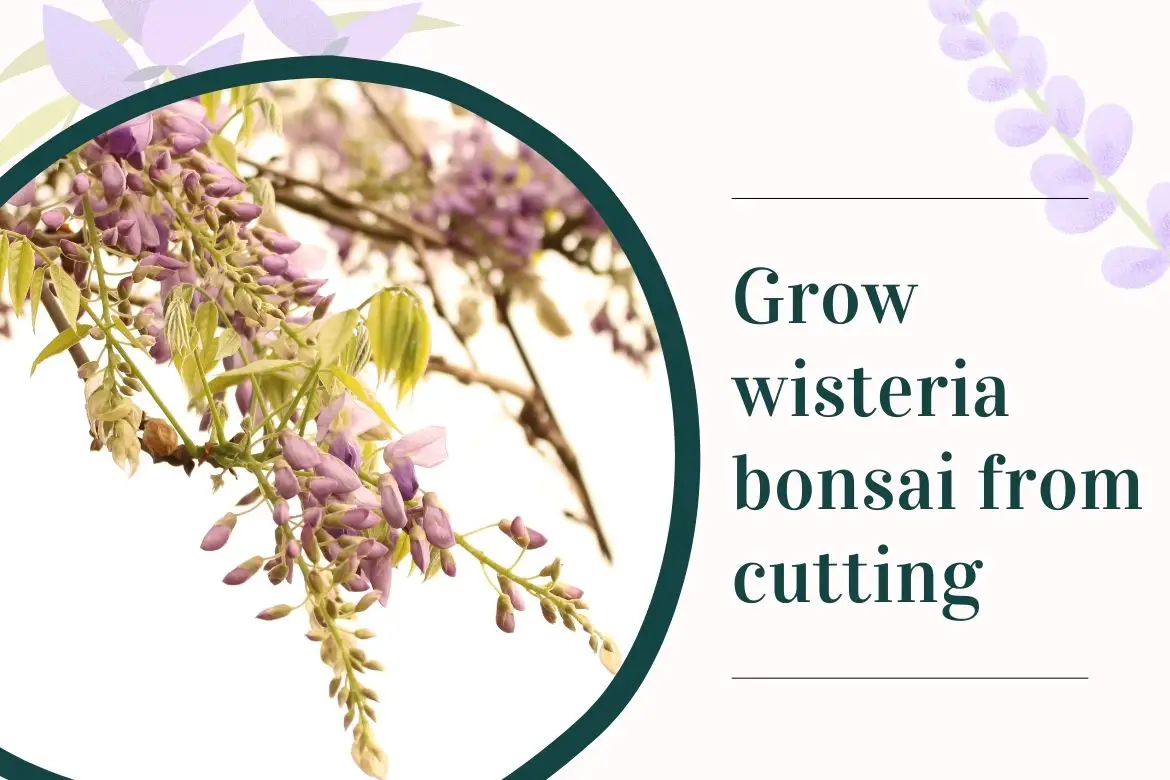Growing a wisteria bonsai from cuttings can be a rewarding experience for bonsai enthusiasts. It’s a relatively simple for bonsai growers of all skill levels and cost-effective way to propagate new plants and create beautiful bonsai specimens.
Here are the steps to grow a wisteria bonsai from cuttings:
- Timing: The best time to take cuttings from a wisteria plant is in late spring or early summer when the plant is actively growing.
- Selecting the cutting: Choose a healthy stem that is about 6-8 inches long and has a diameter of at least 1/4 inch. Make sure that the stem is not too woody or too young and tender. Look for a cutting that has a few leaves at the top but is mostly bare at the bottom.
- Preparing the cutting: Use a sharp, clean pair of pruning shears to make a clean cut at a 45-degree angle just below a leaf node. Remove any leaves from the bottom half of the cutting, leaving only two or three leaves at the top.
- Rooting hormone: Dip the cut end of the wisteria cutting into rooting hormone powder, shaking off any excess. When selecting a rooting hormone for wisteria cuttings, look for a product that is specifically formulated for woody cuttings
- Potting mix: Prepare a well-draining potting mix by mixing equal parts of perlite, peat moss, and coarse sand. The ideal temperature for rooting wisteria cuttings is between 68 to 77 degrees Fahrenheit (20 to 25 degrees Celsius). This temperature range provides the right conditions for the cuttings to develop roots and grow into healthy plants.
- Planting the cutting: Make a small hole in the potting mix and insert the cutting into the hole, making sure that the cut end is in contact with the potting mix. Gently press the potting mix around the cutting to hold it in place. It is important to keep the cuttings warm and humid during the rooting process, as this will help promote root growth. However, it is also important to avoid excessive heat, as this can cause the cuttings to dry out and fail to root.
- Watering: Water the cutting thoroughly, making sure that the potting mix is evenly moist but not waterlogged. One way to ensure proper watering is to mist the cuttings several times a day using a spray bottle. It is also important to make sure that the potting soil is well-draining, as waterlogged soil can lead to root rot and other problems. Regularly check the soil moisture level by inserting a finger into the soil up to the first knuckle. If the soil feels dry, it is time to water.
- Light: Place the pot in a bright, but not direct, sunlight. If the weather is too hot, it’s better to place the pot in partial shade. Keep the potting mix moist by watering as needed.
- Transplanting: After about 6-8 weeks, check for roots by gently tugging on the cutting. If you feel resistance, the roots have formed, and it’s time to transplant the cutting to a larger pot with well-draining potting mix.
- Training: Once the wisteria cutting has been transplanted to a larger pot, you can start training it into a bonsai form. Trim back the shoots to encourage branching and shape the plant using wire. Continue reading wisteria bonsai tree care and How to bonsai a wisteria.
How long does it take for wisteria cutting to grow?
It usually takes around 6 to 8 weeks for wisteria cuttings to develop roots and start growing. However, the time can vary depending on factors such as the temperature, humidity, and the health of the cutting. It’s important to be patient and not to disturb the cutting during this time, as it needs time to establish itself before it can start growing.
Once the roots have formed, you can start to gradually introduce the cutting to more light and begin to fertilize it to encourage growth. With proper care, a wisteria cutting can develop into a beautiful and healthy plant in just a few years.
Can wisteria be rooted in water?
Yes, wisteria cuttings can be rooted in water. However, it is important to note that wisteria cuttings tend to root better when propagated in a well-draining soil mix with rooting hormone. When rooting in water, it is important to change the water frequently and ensure that the cuttings receive adequate light and warmth to encourage root development. Additionally, once the roots have developed, the cuttings should be gradually acclimated to soil to avoid shock when transplanted.


